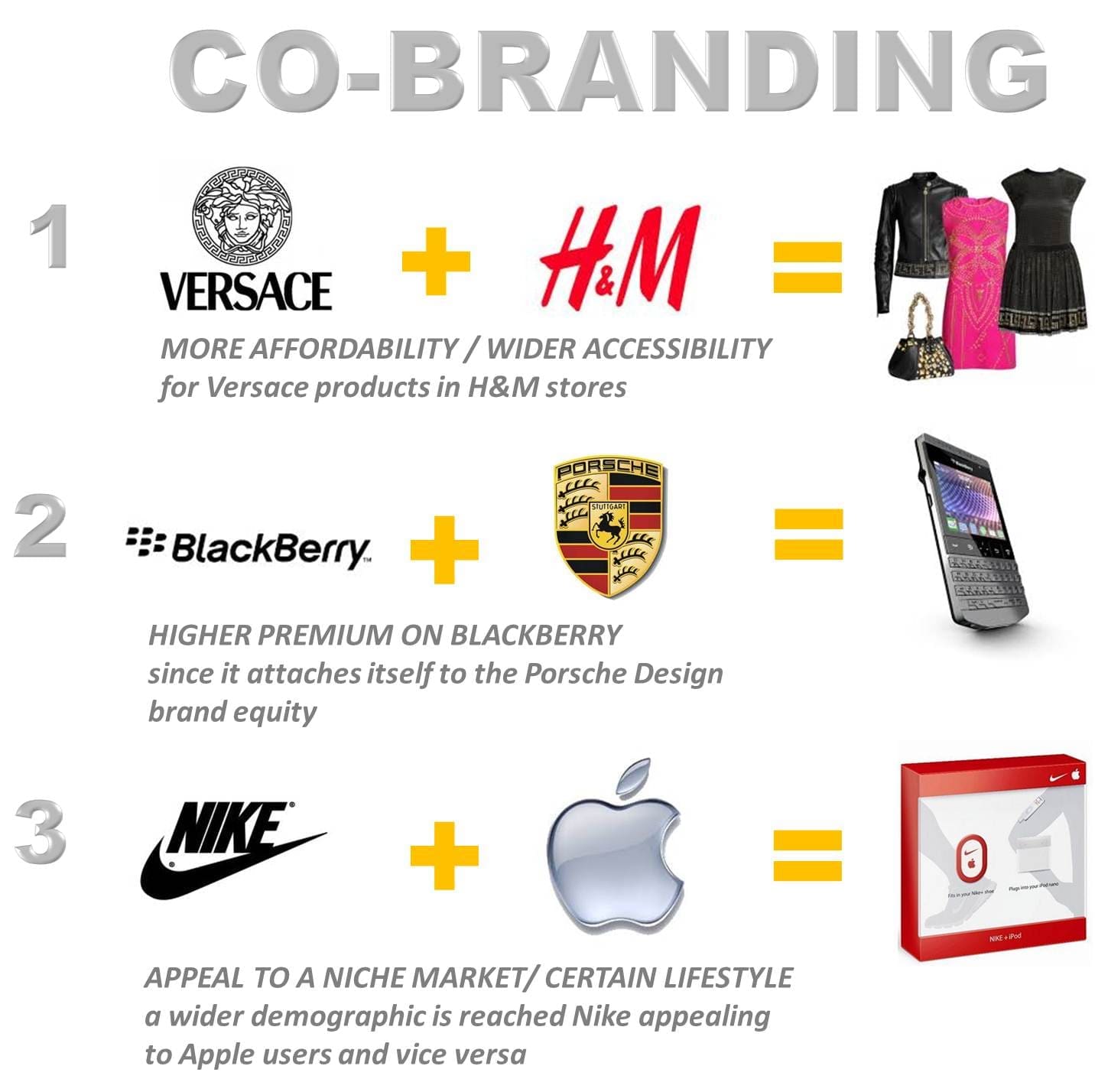Co-Branding : The Art Of Collaboration
Rushin H Vadhani
AGM-Marketing
AYM Syntex Ltd.
(Formely Welspun Syntex Ltd)
1
Co-branding is an arrangement that associates a single product or service with more than one brand name or otherwise associates a product with someone other than the principal producer. The typical co-branding agreement involves two or more companies acting in collaboration to associate any of various logos, color schemes, or brand identifiers to a specific product that is contractually designated for this purpose. The object for this is to combine the strength of two brands, in order to increase the premium consumers are willing to pay, make the product or service more resistant to copying by private label manufacturers, or to combine the different perceived properties associated with these brands with a single product.
When two or more companies are in a co-branded relationship, they are endorsing each other in an attempt to build a more successful brand than would have been built individually. Co-branding in its purest form has at its core the exchange of values or attributes (on a reputational level) between brands, to create a new reality whereby both brands are perceived to be better as a result of the initiative. These brand partnerships are common among consumer markets, especially between manufacturers & retail brands.
Forms of Co-branding :
There are many different sub-sections of co-branding. Companies can work with other companies to combine resources and leverage individual core competencies, or they can use current resources within one company to promote multiple products at once. The forms of co-branding include: ingredient co-branding, same-company co-branding, national to local co-branding, joint venture co-branding, and multiple sponsor co-branding. No matter which form a company chooses to use, the purpose is to respond to the changing marketplace, build one’s own core competencies, and work to increase product revenues.
One form of co-branding is ingredient co-branding. This involves creating brand equity for materials, components or parts that are contained within other products
Co-branding is an important strategy for the transition of brands. For multinational companies with global brands, it raises the chances of success in local markets. For local firms with strong brands, it secures their future through foreign investment and access to technology while maintaining consumer franchise and loyalty.
The decision about whether to co-brand is based on two conditions: the opportunities for creating a competitive advantage, and the operational benefits that will result. When these conditions are favorable, a firm must pick the right cobranding partner, using such criteria as (a) compatibility between brands, (b) market volatility, (c) investment requirements and arrangements, and (d) the prospective partner’s commitment to the agreement. The firm and its chosen partner then enter the phase of courtship and potential conflict, which involves planning, negotiation, and conflict avoidance and management. Finally, they must create an exit strategy, in case the co-branding arrangement fails to live up to its promise.
The potential upside to such alliances is significant. Brand owners can expand their presence into new markets, take advantage of market research/data acquired by partners to leverage their brands and share marketing expenses of the co-branded product or service. Less obvious are the problems inherent in such arrangements. So many variables are beyond a company’s control when partnering with another brand. Special consideration needs to be taken to ensure that
- ownership of Intellectual Property (IP) is clearly defined;
• an exit strategy is in place if a partner’s brand is declining in popularity;
• marketing strategies of the parties are aligned;
• confidentiality provisions are in place to protect proprietary information;
• quality control over the co-branded product or service is exercised;
• and rights to enforce combination marks are retained.
Strategies for Successful Alliances
Who owns the IP?
Establishing who owns rights in a joint brand is essential to the success of a co-branding campaign. Who has the right to register the combined mark? Who has right to use it following termination of the relationship? IP is often developed around the alliance, such as taglines, websites, content, domain names and hashtags. Determining ownership of these assets at the outset of a relationship is critical. Continued use of a joint brand after termination of the contract can create confusion in the marketplace and dilute the value of the individual brands. Worse, an established brand can be tarnished and goodwill lost if the brand owner does not retain rights to monitor quality, control licensing and enforce the composite mark.
Joint Ownership of Brands
The Patent and Trademark Office will grant registration of a composite mark to owners of separate parts of the composite only in appropriate situations.
Develop an Exit Strategy
When partnering with another brand, many factors are outside the control of the brand owner. For example, a car company may recall a vehicle due to a manufacturing defect or a celebrity may be involved in a scandal during a co-branding campaign. It may become clear early on that the campaign is not gaining the traction that was hoped for. Planning for unanticipated events such as bankruptcy, dissolution of parties, a buy-out by a third party, or simply declining popularity of one brand is critical to preserving brand equity. Parties should consider stipulating in an agreement a relatively short trial co-branding period. If the campaign is successful, the parties can extend the agreement. If not, the contract can be terminated early without too much investment or damage to the brand.
Other Considerations
When partnering with another brand, making sure the parties’ marketing strategies are aligned is crucial. Developing a style guide for the combined brand—and agreeing on packaging and print advertising standards—will ensure that the marks are used in a consistent manner. Parties should also address how content will appear online and on social media platforms, what hashtags will be used and who will manage postings.
Agreements should also address
- the confidentiality of proprietary data exchanged during and after the relationship
• the ability of the parties to exercise sufficient control over the quality of the co-branded product
• and who will be responsible for enforcing the composite mark.
Addressing these issues at the outset of a relationship will greatly increase the odds of a successful alliance.
Some advantages to a co branding exercise include :
- Shared resources
- Reduced costs and hence higher margins
- Branding boost especially if both the brands are renowned
- Shared risk – All the risk is not borne by one brand
- Better sales and better customer relations
- Financing becomes easier as two brands are intertwined.
There are several disadvantages to a co branding exercise :
- If anything goes wrong, both the brands are affected
- Brand alliance might be positive or negative in consumers mind and might not achieve the desired effect.
- If one brand enters too many co brand exercises, it dilutes itself, and hence the other brands it has associated itself with.
- Consumers may prefer the bundling above the individual offering, thereby dropping the value when the co branding exercise ends.
- Consumers may not focus on the individual brand altogether, thereby causing the co branding exercise to fail.
Thus, keeping the above disadvantages in mind, Managers have to take the right decision whenever it comes to co branding exercises. The brands need to be aligned in the right manner to give a positive impact in the market. This can be done in the planning and tie up stage before the implementation of the co branding exercise.
Example :
INVISTA, the manufacturer of LYCRA® fiber co-brands with leading fashion labels.
In addition to showcasing the latest styles from these brands, the marketing campaign informs consumers where they can purchase the stylish apparel made with the comfort and high-performance of LYCRA® fabrics.
More than 92 percent of female consumers in the U.S. are aware of the LYCRA® brand and associate it with such positive attributes as high quality, modern, stylish and flexible.
That perception translates into jeans that hold their shape and provide a custom-like fit.
LYCRA® fiber first appeared in denim segment during the mid 1970s. After decades of LYCRA® fiber innovations for denim apparel, the brand evolved even further when INVISTA introduced XFIT LYCRA® fabric. The new technology allowed designers to develop denim that would stretch and recover in all directions, providing jeans with exceptional comfort and fit. LYCRA® dualFX™ fabric was added to INVISTA’s line of denim concepts, fulfilling consumer demand for jeans that could stretch 30 percent or more without compromising lasting fit and recovery. LYCRA® Style fiber entered the marketplace with the highest recovery levels versus three leading brands of spandex in denim tests.
Conclusion :
Strategic partnerships like that one can be a highly effective way to build a business, boost brand awareness, and break into new markets. The whole point is that the success of one brand will bring success to its partner brand, too. But for a partnership to truly work, it has to be a win-win for all players in the game. The value perceptions, target audiences, prices, and promotion channels need to match.
Key References :
- knowledge.instead.edu
- hbr.org
- invista.com
- https://en.wikipedia.org/wiki/Co-branding
- managementstudyguide.com/co-branding.htm
- Book -Co-Branding: The Science of Alliance: Tom Blackett, Bob Boad
*Disclaimer: The views and opinions expressed in this article are those of the author in his personal capacity of knowledge & perspectives on the mentioned subject .



